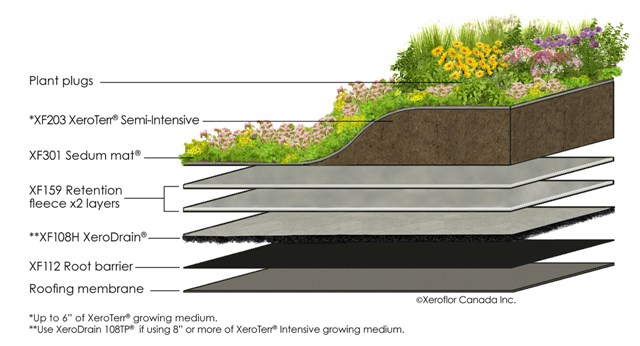Aug 3 2015
While it may appear simple on the outside, considerable product engineering, research and testing goes into a minimalist green roof to ensure it achieves the necessary performance goals. A minimalist green roof strips away unnecessary elements and focuses on what needs to be there to achieve its desired goals from aesthetics to stormwater management.
 Embracing minimalism does not mean being less creative. As this 3D shows, the hybrid XF301 Lili Terrace is a minimalist green roof system that offers a custom design option. (CNW Group/Xeroflor Canada Inc)
Embracing minimalism does not mean being less creative. As this 3D shows, the hybrid XF301 Lili Terrace is a minimalist green roof system that offers a custom design option. (CNW Group/Xeroflor Canada Inc)
One such simple system, the XF301 Sedum Light (click to watch video), is among the lightest green roofs available, and is found on landmark rooftops around the world including the Ford Truck Plant in Michigan, USA. Ford's architect William McDonough called the XF301 system "the Holy Grail" of green roofs for its high-performance and lightweight features that effectively capture and store rainwater without exerting excessive loading. At a total profile of 65 mm (2.6"), the XF301 has an excellent "water retention-to-weight" ratio weighing 49 kg/m2 (10 psf) at saturation with a maximum water storage of 27 l/m2 (0.69 gal/sf).
The roots of this minimalist approach go back to 1972, in Germany, where the system was first developed and vigorously tested for wind, fire, and root resistance by third parties. The success of a minimalist design is evident with millions of square feet covering rooftops across four continents more than four decades later. This technological advancement made it possible to retrofit existing buildings without the need for structural reinforcement, though a structural engineer should always be consulted. As a result, building professionals can turn almost any rooftop into a green oases and achieve greater sustainability.
Through innovations, the minimalist system offers many of the same benefits as heavier, more cumbersome growing-medium based green roofs. While it effectively captures stormwater, extends the lifespan of the roof membrane, lowers cooling costs and reduces the city's "heat island" effect, it is lighter in weight and more likely to meet the weight restrictions of existing buildings. The XF301 system is comprised of a pre-vegetated mat loosely laid over high-performing baselayers. Much like sod, the mat is quick and easy to harvest, transport, install, and even retract if necessary.
Embracing minimalism, however, in no way means being boring, or less creative. The durable and flexible components of an XF301 system conform to almost any rooftop design but can be easily altered to create a fusion of semi-intensive green roof features such as growing medium and plant plugs of your choice. The XF301 Lili Terrace is a hybrid green roof system where the sedum mat is draped over varying depths of engineered growing medium (where the structure allows), offering a custom made solution and a seamless transition between low and high profile designs. This is a creative option for rooftops with varying loads and may allow for an undulating roofscape with topographic variation and increased biodiversity.
When it comes to green roofs, there is no one-size-fits-all solution. The system must be designed and optimized for the building itself, as well as the local climate. While different systems offer different benefits, a minimalist pre-vegetated system might be the perfect choice to get the job done.
Principal Components of a Minimalist Green Roof
Pre-vegetated mat with engineered growing media includes up to 12 species of sedum and a variety of mosses. The mat is directly placed on loose-laid synthetic baselayers.
Water retention baselayers are composed of 100% post-consumer recycled materials and are lightweight and highly effective in storing water compared to growing medium on a per-unit-weight basis.
Drainage layer is a high drainage capacity mat with excellent durability. It keeps the roof properly drained and the green roof healthy and strong. It conforms to irregular surfaces, shapes and slopes.
Root Barrier is a 20 mil highly flexible, low density polyethylene membrane proven to protect the roofing membrane from aggressive plant roots.
All components above come in compact rolls for economical transport and a simple and fast installation.